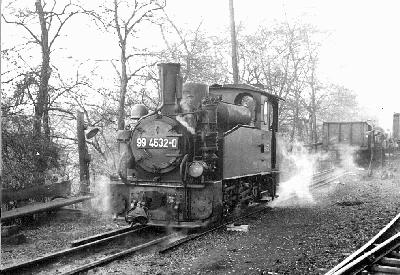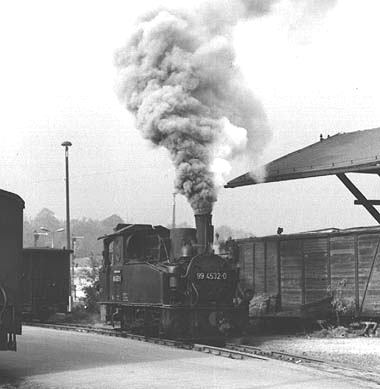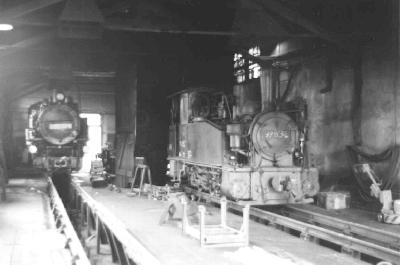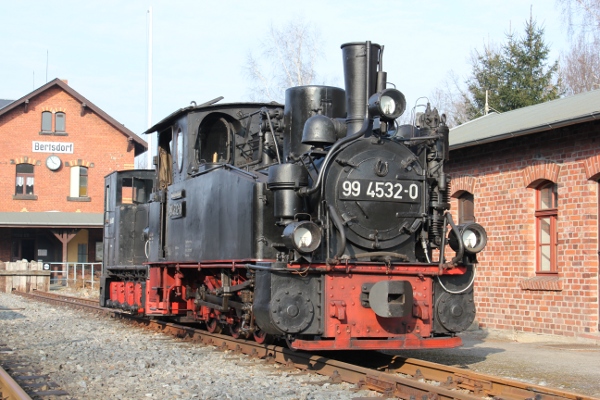Vehicles of the club
The Zittau 99 4532

History of the locomotive
Built under the factory number 10844 in 1924 by the company Orenstein and Koppel, it first came to completion after being completed in Thuringia Narrow gauge Trusebahn used. On this leading from Wernshausen to Herges-Vogtei (later renamed Trusetal) leading track was already since 1909 one identical locomotive in use. This also supplied by Orenstein and paddock locomotive with the factory number 3177 wore first the name "Glückauf" and later the Company number 99 4531. The much later delivered 99 4532 received in their new home the name "Trusetal" and only after the takeover of the private Trusebahn by the Reichsbahn in 1949 the new, until their release in 1989 valid operating number, which only when introducing computer processing at the German Reichsbahn in June 1970 was supplemented by the self-check digit. An unexpected "honor" came to the 99 4532 in 1992. In preparation for the creation of a uniform railway administration in meanwhile reunified Germany resulted in the need for an adjustment of the German Federal Railways and Germans Reichsbahn different operating numbers for traction vehicles. Although parked since 1989 not working and not even for a refurbishment provided (the official z-position took place on 07.08.1990), arrived for the sake of order also the 99 4532 in this Umzeichnungsplan and calls itself since 01.01.1992 now 099 760-1. This new company number was only a theoretical thing, as it was never attached to the locomotive.
After their arrival on the Trusebahn, 99 4532 together with its sister machine performed the majority of the train services. Only at times after the takeover of the Reichsbahn were these two relatively weak locomotives dispensable, above all with the stationing of otherwise mainly in Saxony used 1E1 Neubaudampflokomotiven from the VEB Lokomotivbau "Karl Marx" Babelsberg. The first was 99 786, which in January 1955 in Wernshausen arrived. It followed in October 1956 the 99 794 and finally put in August 1959 the 99 772 to Trusetal, so that one could renounce from 1958 to the services of 99 4531. In 1959, 99 4532 was dispensable on its long-standing mainline, so that it reached the RAW Görlitz and her repeated work appeared questionable. Although now one of those unpopular loner, she was again worked up in 1962 and then sent to Rügen to the local narrow gauge network. Obviously you could not make friends with 99 4532, whereupon the locomotive came to Zittau in 1963 and found its second, long-time home here.
The test drive in Zittau completed 99 4532 together with the auxiliary train to Olbersdorf-Oberdorf, but it was already apparent that this locomotive for the relatively strong gradients on the Zittau narrow gauge railway was too weak. It is unlikely, however, that a deployment on the track was intended. For the Use as a shunting locomotive received 99 4532 a simple funnel coupling. At the same time, with the arrival of 99 4532, the last locomotive of the former genus IV K turned off 99 595. This meant the end of the scheduled use of this locomotive series in Zittau after 55 years!
During her 26-year shunting-house existence in Zittau, 99 4532 was tirelessly busy with the marshaling tasks, such as making and shunting Resolving freight trains, replacing damaged passenger carriages and, of course, maneuvering at the trolley pits. Only on the weekends received 99 4532 "off duty" and was allowed to rest in the engine shed, while then loading and unloading the standard gauge freight wagons at the trolley pits of the as a freight locomotive used 1'E1 'unit locomotives was even carried out.

At the beginning of their mission in Zittau there were often problems with derailments, which were eliminated by a reconstruction in the RAW Görlitz. Among other the suspension was optimized, as well as the locomotive with some weights provided for mass balance. Nevertheless, 99 4532 did not get into service again, not only because of the low performance, but because you probably continue with derailment or at least problems in the tight curve radii (for example, entrance Bf. Zittau suburb) on the Route expected. Although this is not so comprehensible, since even on the narrow gauge of the station Zittau very narrow radii were used, but for 99 4532 was Thus, the limit of their field of application on the signal Ra 10 (Rangierhalttafel) at the level of the interlocking W1 the standard gauge.
Over time, 99 4532 has become increasingly popular with operators, not least because of its ease of use and economy Coal consumption was. Thanks to its robustness and popularity with the staff, 99 4532 has also been refurbished every time the locomotive is damaged. So Among other things, she received a regulator as well as the fire door of an IV K, as the original components could no longer be used. It also tried Bahnbetriebswerk Zittau obviously always "to keep its" small shunter, but the use of a large 1E1 unit locomotive for maneuvering was not only more expensive, but due to the poorer visibility when loading and unloading in the trolley pits also unfavorable from the operational point of view. Not least an argument for the 99 4532 was the In fact, her boiler output made her ideal for maneuvering, while the unit locomotives had problems with too much steam. As a result, which was driven only on "low flame" with them. That something was not good for the cauldron, should be known. Last but not least impressed in the 80-iger years constant lack of locomotive on the narrow-gauge railway the events in Zittau (at times were despite Lokhilfe of other narrow-gauge railways with 6 locomotives needed daily only 3 operational machines available, so that even passenger trains had to be driven in rail replacement traffic).
Only from the endeavor of the Zittau railway depot to have an efficient shunting locomotive it seems possible that 99 4532 always returned to Zittau. So also in 1987, when the shunting locomotive stayed for a RAW-stay and afterwards on the occasion of the 34th MOROP congress for the vehicle exhibition in Bf Erfurt West. All of a sudden, a locomotive of the former Saxon genus IV K appeared in Zittau as a replacement. It was 99 1606. "Under the hand" spread at that time the rumor, 99 4532 had been sold on the locomotive exhibition a purchase-strong prospective customer from the then brD. That was not the case, you could Three months later, when 99 4532 arrived back in Zittau. Nevertheless, it seems surprising that 99 1606 was transferred to Zittau. Maybe it was the return 99 4532 but also because of the Zittau Bahnbetriebswerk persistently refused to use 99 1606. During her stay of several months in Zittau 99 1606 heated only once on a trial basis, but moved on the Zittau narrow gauge railway not a single meter on their own. Also, partly in the trade press claimed, use before special trains or the like did not take place! The reason for the non-employment among others was that the Zittauer locomotive crew on this Lokbaureihe have no experience and just when maneuvering the security can not be guaranteed.
Nevertheless, the further use of Lok 99 4532 in Zittau should now only take more than 2 years. As for a necessary extension of the boiler period in the fall of 1989 a piece was cut out of the standing boiler and sent to Brandenburg-Kirchmöser for material testing, came the "Aus" for 99 4532. The still existing Original boiler from 1924 was no longer usable for a work-up for material reasons. A briefly considered reduction of the boiler pressure was as discarded as the thought of a reconsolidation. Since now by the political development after the wall opening of the goods traffic on the narrow-gauge railway, After a short upswing, with the closure of most of the follow-up companies getting smaller and smaller, the question of a reconditioning did not come up, but it was an extra Rangierlok no longer needed.

However, the machine remained in Zittau, where it with the other vehicles on 30.11.1996 to the SOEG passed over. After lengthy negotiations, the machine was successfully acquired by SOEG on 01.02.2001. Unfortunately, one is workable processing currently not possible because the necessary funds are missing. Thus, the funds collected in the fundraiser after the acquisition now to Conservation of the current condition used. The locomotive can be visited to the "Days of open engine shed" and at events such as the 9th Dresden Steam Loco Festival or the Eibauer Bierzug. In 2003 she is celebrating her 40-year-old loyalty to Bw Zittau.

Use data
| Trusebahn AG | 01. September 1924 - 01. April 1949 |
| Bw Meinigen | 15. December 1950 - 12. December 1958 |
| Bw Putbus | 28. March 1962 - 08. July 1963 |
| Bw Zittau | 09. July 1963 - 29. November 1996 |
| Property of the SOEG | 30. November 1996 - 31. January 2001 |
| Property of the IV | 01. Februar 2001 |
